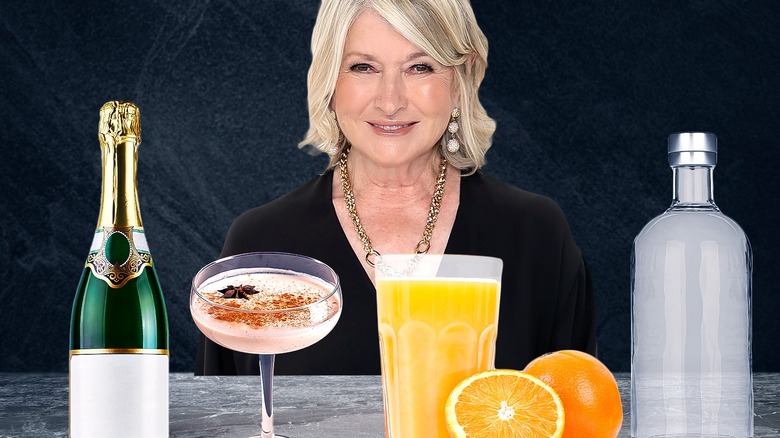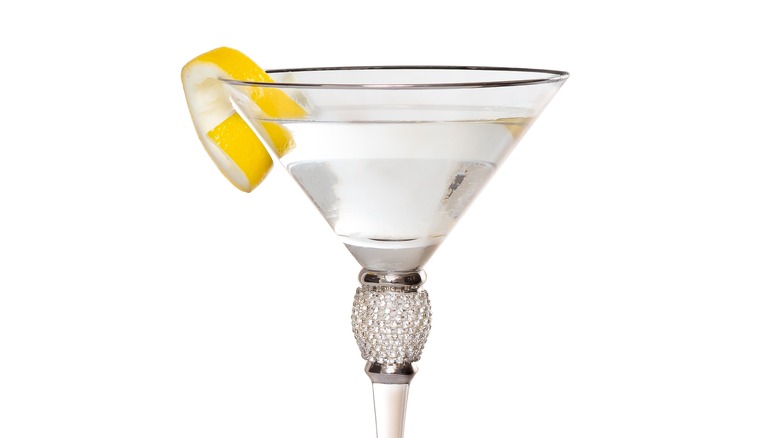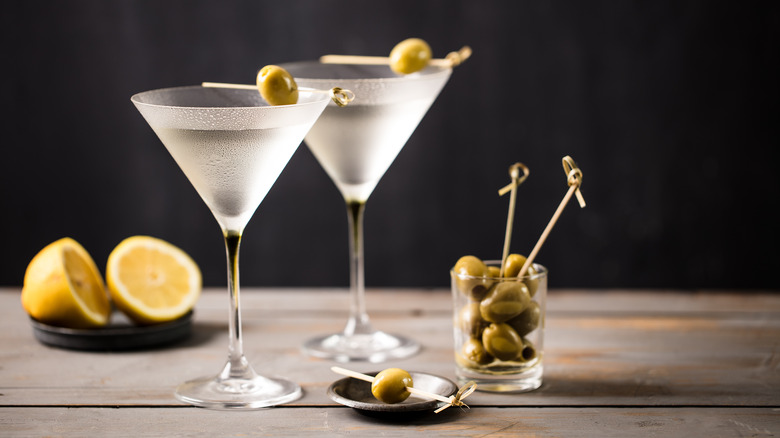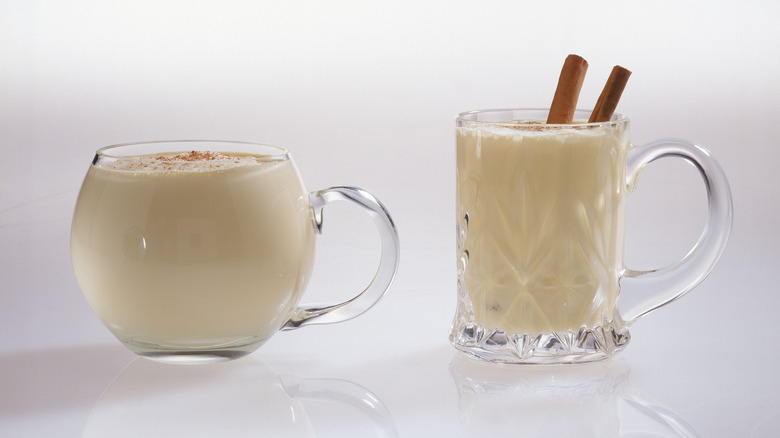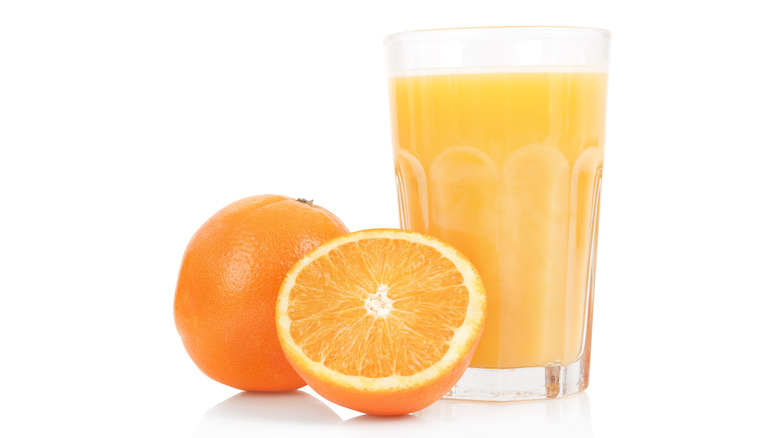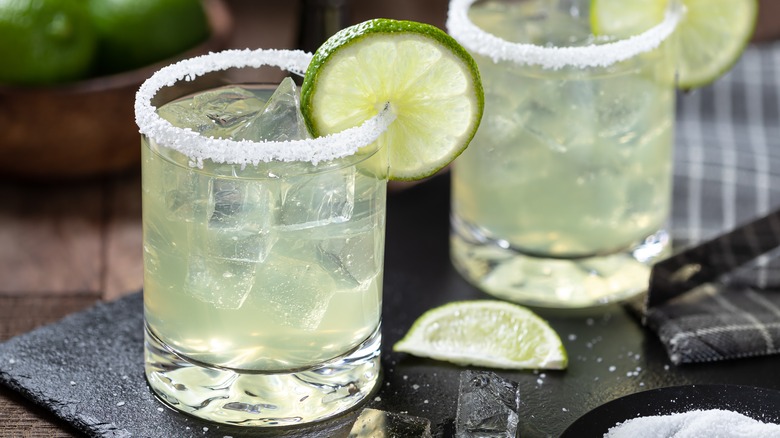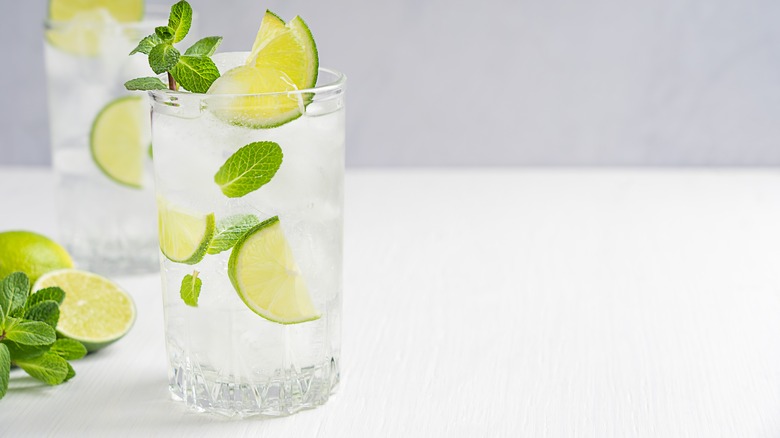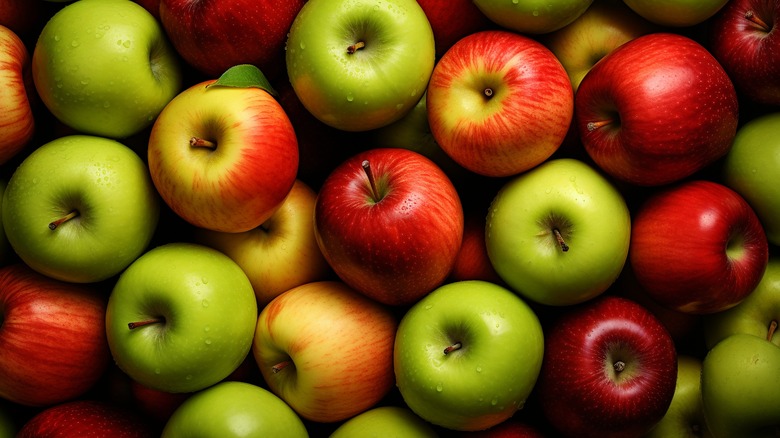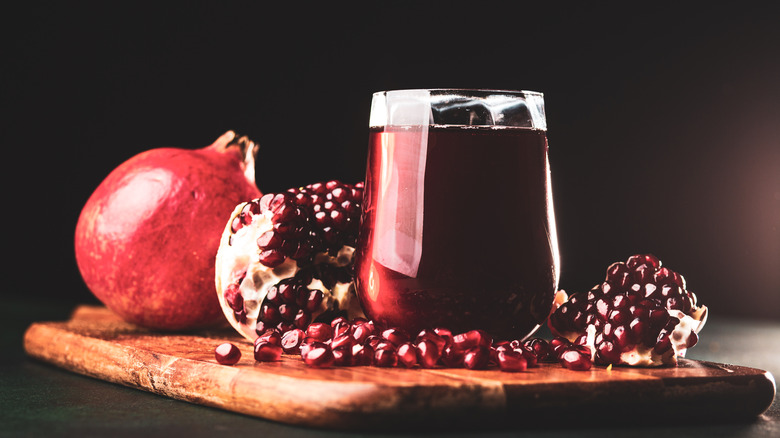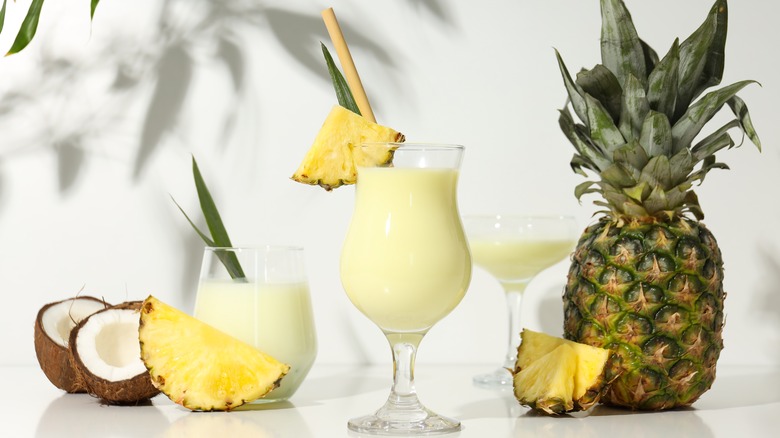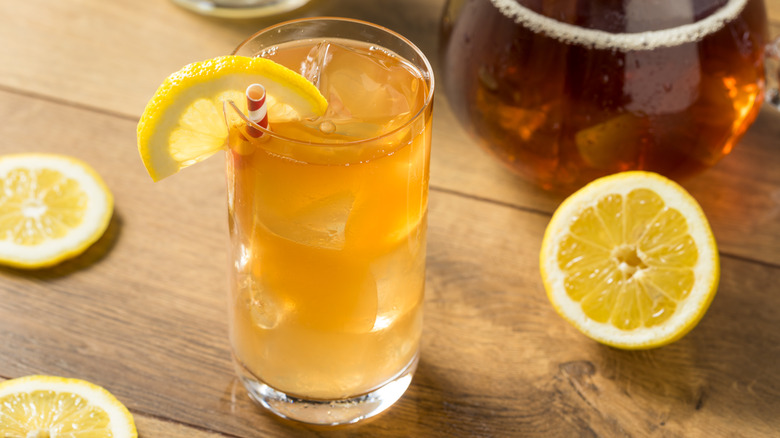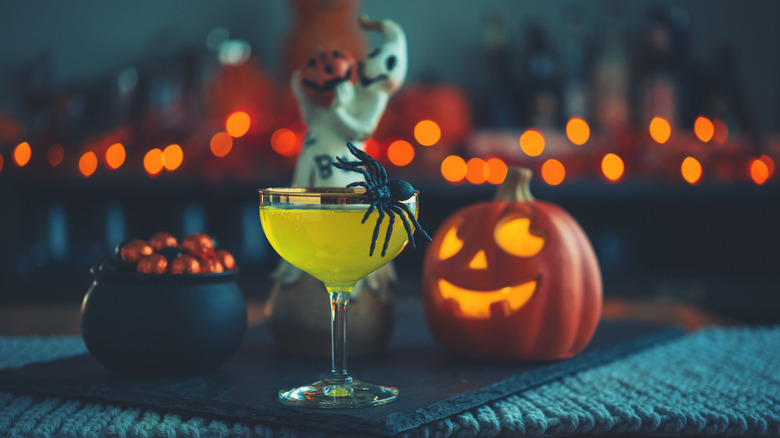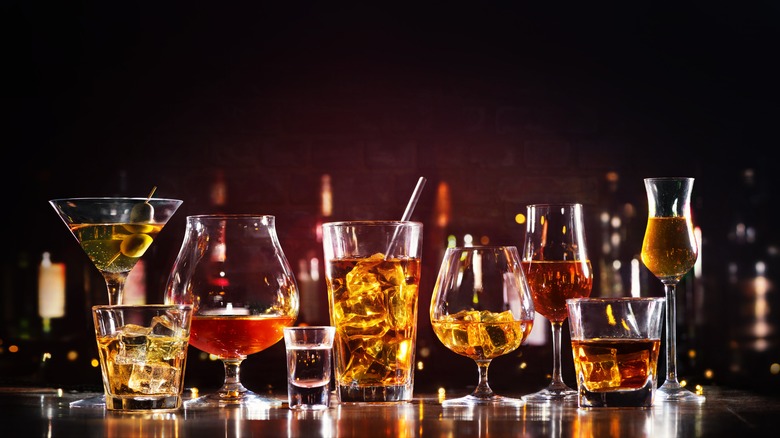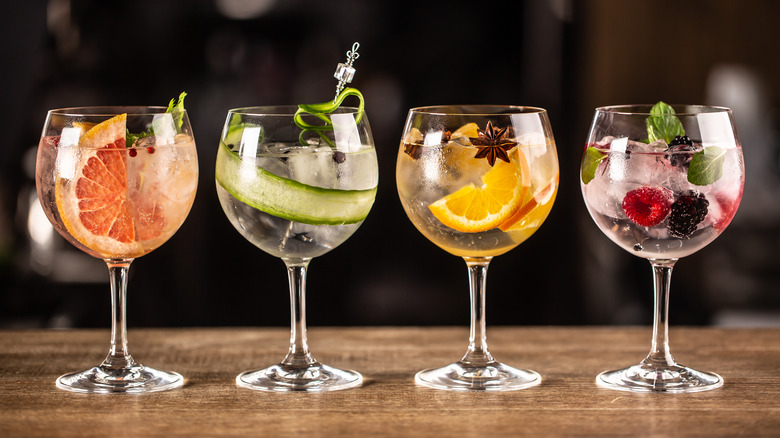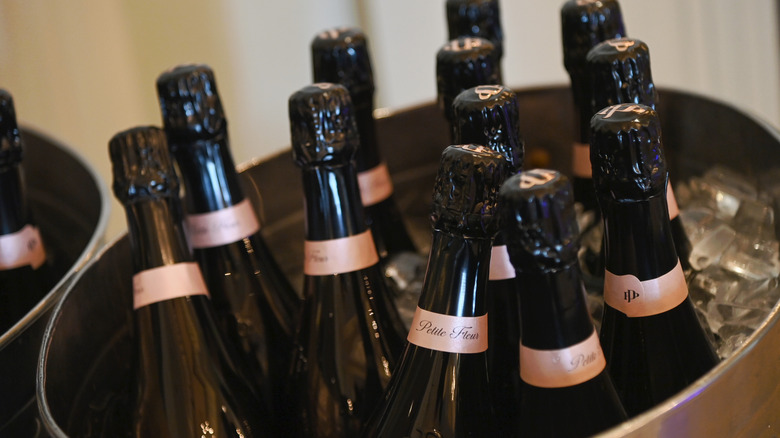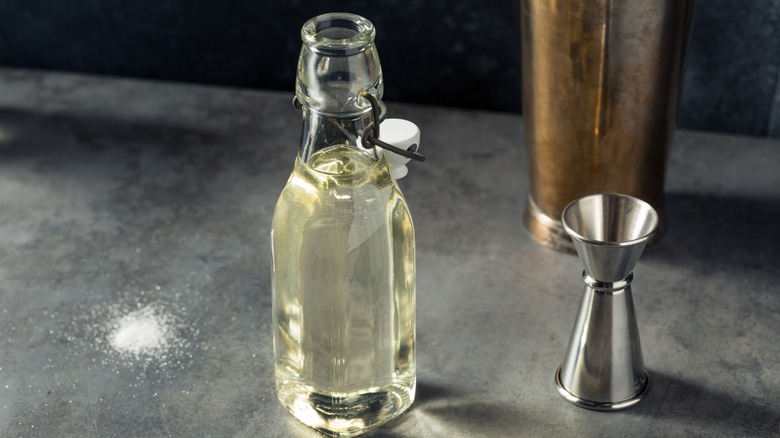Martha Stewart's 15 Best Tips For Making Cocktails
The name Martha Stewart is synonymous with entertaining at home thanks to, among other things, her creativity in the kitchen and expertise in making cocktails. Now, alcoholic drinks may not be necessary to throw a fun gathering but cocktails can help break the ice among partygoers and keep the conversation flowing. Better drinks allow this environment to take hold more easily, as well, which explains why we often turn to Stewart to help us transform a simple drink into an extraordinary experience.
Stewart has shared her passion for high-quality cocktails through her various television shows, cookbooks, and online platforms. Her approach to mixology is characterized by meticulous attention to detail, an unwavering commitment to fresh ingredients, and an innovative flair that redefines classic concoctions — elevating the most basic drink into an art form.
Whether crafting an uncomplicated mojito or orchestrating an elaborate champagne cocktail, Stewart's expertise comes through in both the precision of her measurements and the finesse with which she presents each creation. Many of her recipes seamlessly blend tradition with modernity and offer a refreshing take on timeless libations, and we decided to take a look at some practical ways to learn from the culinary icon. Here are Martha Stewart's 15 best tips for making cocktails at home.
Use high-quality vodka
If you use subpar ingredients, you're going to end up with a subpar cocktail. Consequently, the living legend never settles for anything less than top-shelf vodka, particularly when it comes to Martha Stewart's favorite cocktail: the lemon drop martini.
More specifically, Stewart enjoys Belvedere (a brand of Polish vodka). She pairs the Belvedere with juice from Meyer lemons — which are sweeter and easier on the tongue than other lemon varieties – and a simple syrup she makes with Meyer lemon zest. These ingredients are then combined with Cointreau for an added citrusy vibe.
Since we're talking about high-quality liquor here, why not substitute in a classy Grand Marnier, another orange-flavored liqueur, for good measure? The most important factor in this drink is ultimately the Belvedere, after all, which lends a nutty, grassy undertone (one that nicely complements the lemony flavor without overwhelming it). Just be careful as Belvedere also has an incredibly smooth profile — and you might not even notice it's there.
Serve martinis ice-cold
When it comes to making a good martini, whether you choose gin or vodka is irrelevant as long as you use a high-quality alcohol. However, the temperature is non-negotiable. After all, when Martha Stewart told us the keys to a perfect martini, she called it crucial to serve it "icy cold."
There are several ways to ensure your martini is served ice-cold, such as pre-freezing the glasses several hours before making your cocktails. You can also place ice cubes in a martini glass to quickly chill the glassware before adding any liquid. And, as every James Bond fan knows, a martini is best when shaken (not stirred) in an ice-filled cocktail shaker.
Of course, we suggest doing all of the above for the best results. Additionally, don't overdo it with vermouth or olive juice; that way, the vodka or gin you selected for the cocktail can stand out.
Add three types of booze to eggnog
Whether you prefer to stick to the traditional holiday window when serving and consuming eggnog or drink the boozy beverage year-round, don't feel beholden to using a single alcohol when preparing it. Since Martha Stewart loves to load up eggnog with booze, why not follow her lead and amp up your usual recipe with a trio of top-notch alcohols?
Stewart's preference for including three different types of alcohol when making the creamy cocktail may seem excessive. But make no mistake: This isn't a mere matter of increasing quantity or making your eggnog stronger. Rather, it's about giving the drink more depth by using bourbon, dark rum, and cognac — three distinct spirits that bring their unique flavor profiles to the pot.
Stewart suggests adding 3 cups of bourbon, 2 cups of cognac, and ½ cup of dark rum to a party-sized eggnog bowl (one able to serve roughly 26 people).
Always use fresh juice
Artificial or pre-made cocktail mixers were big in the 1980s, but luckily, they seem to have stayed there (for the most part). If you didn't get the memo, heed the words of Martha Stewart, who stresses the importance of using fresh juice every chance she gets. Her caipirinha recipe, for example, relies strictly on freshly squeezed lime juice, along with raw cane sugar and cachaca. Likewise, berry spritzer specifically calls for freshly squeezed lemon juice.
Stewart further suggests serving two to three cocktails like this to your guests before they sit down to dinner –- that way they'll be sure to like your food. This may sound like a lot, and you certainly don't have to go with that figure, but with such quantities, it is helpful to use fresh juice rather than mixers, which tend to be higher in sugar content and other unhealthy additives. So, the next time you want to make a margarita, ditch the mix and head straight to the citrus bowl.
Coat the rim in imaginative mixtures
If you want to be traditional when making margaritas, salt the rim of your glass. Salt plays a crucial role in a classic margarita as its presence instantly awakens our sight, taste buds, and olfactory senses. At the same time, many people find salt to be a bit too much. If you're one of those people? We bring you Martha Stewart's tips on how to bring that margarita salted rim to the next level.
First, roll the rim in citrus juice to make sure that what goes on next stays in place. This is where things get interesting: mix your Kosher sea salt, pink Himalayan salt, or Maldon flakes with chopped rosemary, citrus zest, edible flowers, sumac, or your favorite spice mix, and dip the moistened rim into this combination. With the basics mastered, creating a captivating rim for your margarita becomes an accessible yet creative process.
Keep the ingredient list simple
Considering that Martha Stewart's Cointreau Kiss cocktail only uses four ingredients, she clearly prefers to keep things simple with the cocktails she prepares. For instance, this particular recipe calls for muddled orange slices, Cointreau, Casa Dragones blanco tequila, and sparkling water to finish. An optional fifth ingredient, raw sugar on the rim, adds a simple finishing touch. And that's it.
Aside from the top marks on flavor, drinks with few ingredients make it easier to scale the recipe and fill pitchers with enough cocktails to serve larger parties. Indeed, the Cointreau Kiss can also be a point of departure for many variations you can try by using a spare list of ingredients. For this one, you could switch around the citrus base, substituting Meyer lemon for something a little tangier, or the Cointreau for another fruity liqueur. With so few ingredients involved, it is really hard to go wrong.
Use seasonal ingredients
If you're hosting a party and can't decide which cocktail to prepare for everyone, take inspiration from the season. This will invariably yield fresher ingredients and should also be gentler on your wallet, as in-season produce tends to be bountiful and therefore cheaper. For example, during the autumn, you could try Martha Stewart's Thanksgiving cocktail and utilize the traditional fall flavors.
This apple cider bourbon sour will warm your cockles right up. Just fill your pitcher with bourbon, apple cider, and freshly squeezed lemon juice. The bourbon doesn't just serve as the alcohol factor here -– it'll also add notes of vanilla and caramel that will go nicely with the warm and cozy theme of this drink. Finally, line the rims of your glasses with lemon juice and brown sugar. For a homemade apple pie effect, mix a little cinnamon into that sugar, or pre-make some apple cider ice cubes. Garnish with a fresh slice of apple.
Use pomegranate in margaritas
Once you know the basics of making a good margarita, you can branch out and attempt other variations, of which there are many. We recommend Martha Stewart's pomegranate margarita, aptly named the Martha-rita, which requires an impressive 2 full cups of tequila blanco, 2 cups of freshly squeezed lime juice, ½ cup of triple sec, ½ cup of pomegranate concentrate, and plenty of ice. This yields four generously sized drinks. But why pomegranate? As she says on her Instagram post, "I looove pomegranate," and that's a good enough reason for us.
Before serving the drink, Stewart emphasizes the importance of finding beautiful goblets, to aid in the presentation. As this is a variation on a margarita, don't feel obligated to choose a traditional tumbler. Once the goblets have been chosen, rub some lime on their rims and dip them in salt, sugar, or even an edible flower mix. Be sure to select a good-quality pomegranate juice for this, as its flavor really dominates the drink.
Keep things colorful
No one likes eating gray or drab-looking food, and the same is true for cocktails, which is why Martha Stewart suggests a dramatic cocktail reveal to maximize your presentation. One way she does this is by adding various types of salted rims made with pink Himalayan salt or chili powder. But the most striking method is perhaps that of serving cocktails with bright colors.
Stewart highlights the use of fresh juices in her cocktails but that's not just about the flavor. The fresher the juice, the brighter the color, and that applies just as much to orange juice-based screwdrivers as it does to pineapple juice-based pina coladas. So, make sure your juice is as fresh as can be next time you make a pomegranate cosmopolitan or a grapefruit Paloma. Further enhance the color by adding contrasting garnishes, like a green rosemary sprig with pomegranate, or blueberries with orange juice.
Spike an Arnold Palmer with bourbon
The Arnold Palmer, like the Shirley Temple, is a beloved cocktail from our youth, a drink that as children we could sip on merrily while our parents got even merrier with the real stuff. But that doesn't mean this drink — which is traditionally made with just lemonade and iced tea — must remain in the realm of the PG now that we're all grown up. For instance, you can turn this drink into the perfect beverage for big boys and girls by crafting Martha Stewart's boozy Arnold Palmer recipe.
As it happens, lemonade and iced tea make ideal accompaniments for bourbon. This may be why Stewart's alcoholic Arnold Palmer -– which includes bourbon, lemon-flavored simple syrup, and freshly brewed black tea -– works so well. Remember to let your simple syrup and black tea cool completely before you start mixing the drink. This is supposed to be a cold cocktail, served on ice.
Prepare cocktails to fit the occasion
Inspiration for the right cocktail can come from many different directions. Of course, as you might have imagined, Martha Stewart seems to have a recipe for pretty much any situation. If you're looking for, say, a Halloween-themed cocktail, Stewart's blood moon punch will wow guests at your next spooky gathering.
This cocktail is made by freezing orange juice and then floating it in a mixture of red grape juice, ginger soda, seltzer, fresh lime juice, and vodka for the grown-ups, as explained on her website. Just be sure to freeze that orange juice well ahead of time. You don't want it to thaw too quickly in the punch bowl, or the intended effect will disappear along with it. You can also amp up the spook factor by decorating the bowl with Halloween figurines or playing around (safely) with dry ice, which will ensconce the punch in a literal cloud of mystery.
Other great options include Martha Stewart's long list of Spring-themed cocktails, which are ideal for Easter or Passover, or her cider-bourbon cocktail, which should be a fall and winter mainstay in anyone's home.
Pick the right glass
When preparing a cocktail, you need to have the right ingredients on hand, as well as the tools to manipulate them (but you probably already knew that). What you might not know is that it's equally important to choose the right glass for each cocktail, as the shape of your vessel can impact the drink's taste. As Martha Stewart's website points out, it comes down to the craftsmanship of the glass itself; its shape, size, and thickness all figure into the equation.
This is probably why you've only ever had a martini in a martini glass, at least at bars or restaurants. A tumbler may be less prone to spillage, but using one for a martini would feel wrong (in part because the wide top creates a large surface area for the aromas in gin and vodka to shine through).
Similar logic is at play with other cocktails and types of glasses. For example, any drink with carbonation, such as a mimosa, should be served in a tall narrow glass, which will help retain the bubbles. In all cases, the right glass can elevate the drinking experience by complementing the drink's flavors, aromas, and overall presentation.
Get creative with garnishes
Since we indeed eat with our eyes first, it's not too far a stretch to say we drink with our eyes, as well. This is the reasoning behind many elaborate cocktail garnishes, which more often than not are designed to entice the drinker rather than simply provide flavor. Martha Stewart understands this well, since she provides us with a great guide for creative cocktail garnishes on her website.
Getting creative here doesn't only mean finding strange or unique items to stick into a drink; it's more about what you can do to those garnishes, even commonplace ones. Stewart's recipe for a sugar-frosted fruit garnish, for instance, is simple and easy. Just dip a piece of fruit of your choice (she highlights berries and grapes as ideal options) in simple syrup. Then roll it in sugar, let it dry, and finally spear it and place it on your glass. Other great hacks involve toying around with the mixtures for your salt rim or preparing decorative ice cubes.
Champagne is always best
Bubbly cocktails are a great option for brunch, pre-meal aperitifs, or all on their own. And while you can make a decent cocktail with any sparkling wine — from Prosecco to Cava to anything in between — according to Martha Stewart, none of these will compare to a drink made with the real deal: Champagne.
Although some purists of the drink might say it's a waste to use good Champagne in a drink that could mask some of its flavor, it's also true that to make a great cocktail you need to use great ingredients, and what's greater than Champagne? In fact, the original mimosa recipe, which was invented in The Ritz Hotel in Paris in 1925, called for fresh orange juice and Champagne.
To stay true to the original, do the same, or if you must go off script, at least opt for a bubbly wine made in the classic or traditional method, as Champagne is. This means the wine has undergone a second process of fermentation, causing the bubbles to form directly in the bottle. Drinks made this way include Cava and Franciacorta, but not Prosecco.
Make your own simple syrup
Simple syrup is every bartender's best friend. It can be used in a wide array of cocktails, adding a lingering sweetness without the crunch and discomfort of sugar that hasn't had the time to dissolve. According to Martha Stewart, who shares simple syrup recipes on her website, the best kind is the one made at home, not only because it's generally fresher and tastier, but also because it allows you to infuse it with the flavoring of your choice.
Starting with the basics, all you have to do to prepare simple syrup is cook one part sugar and one part water in a saucepan until the sugar dissolves. Let this cool, and you've got yourself a batch of homemade simple syrup. For something more involved, you could replace the water with brewed Earl Grey tea or freshly squeezed and strained lemon juice. Or you could grate some citrus zest into your sugar and water mixture for a gentler zest. And don't be afraid to play around with the sugars: a dark, flavorful demerara sugar imparts nutty caramel notes to simple syrup.
